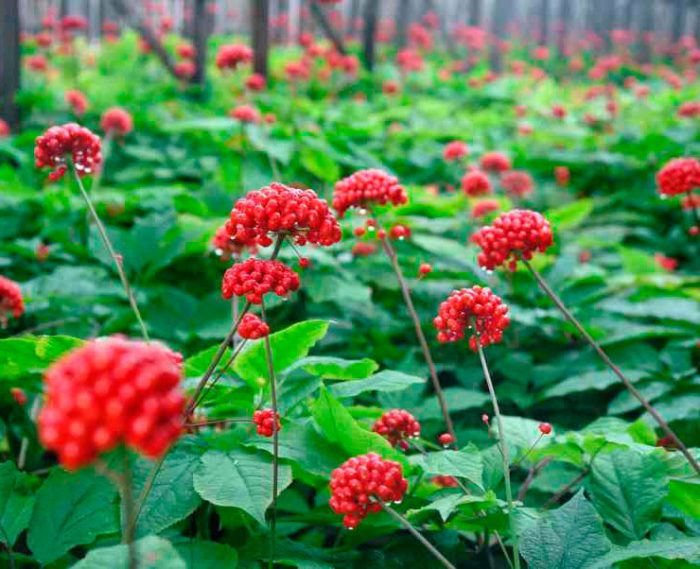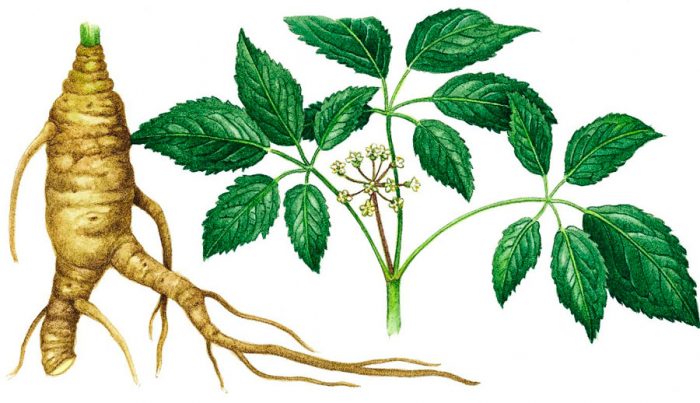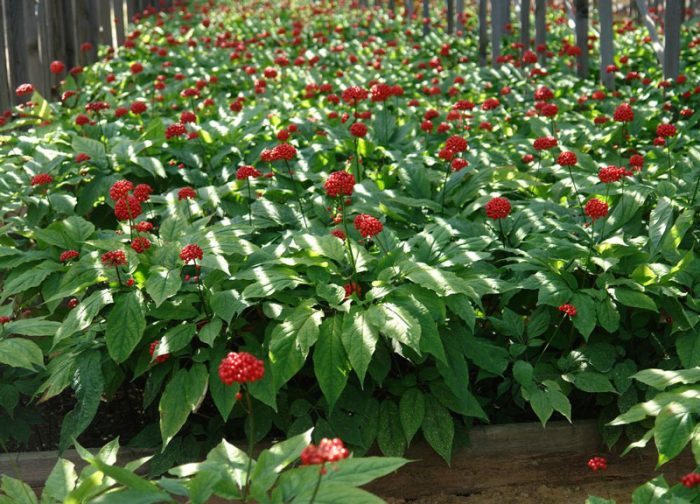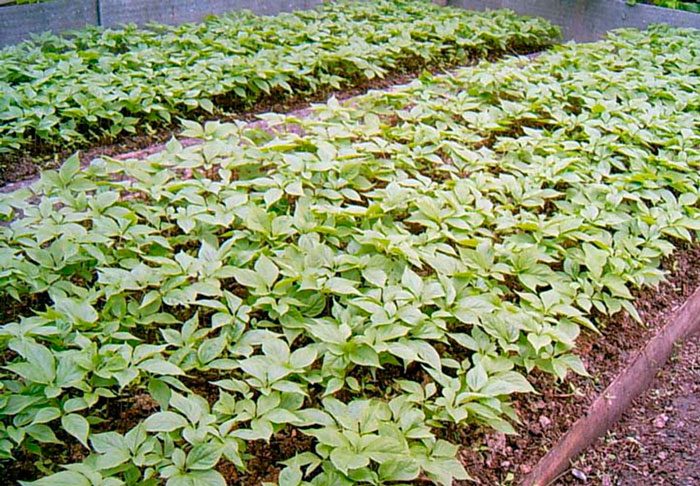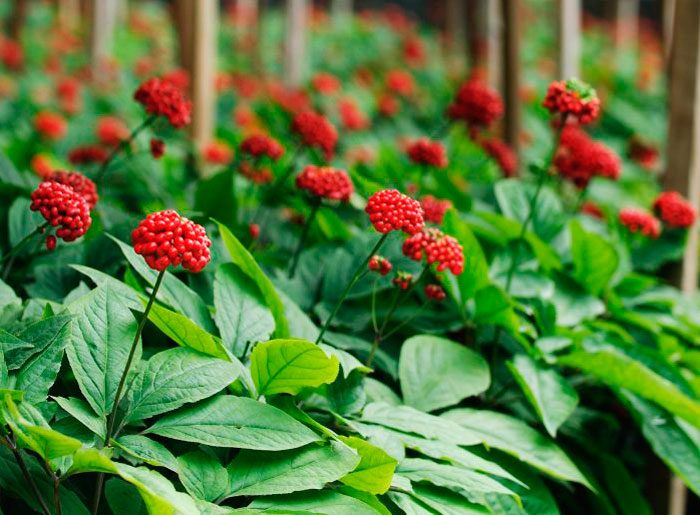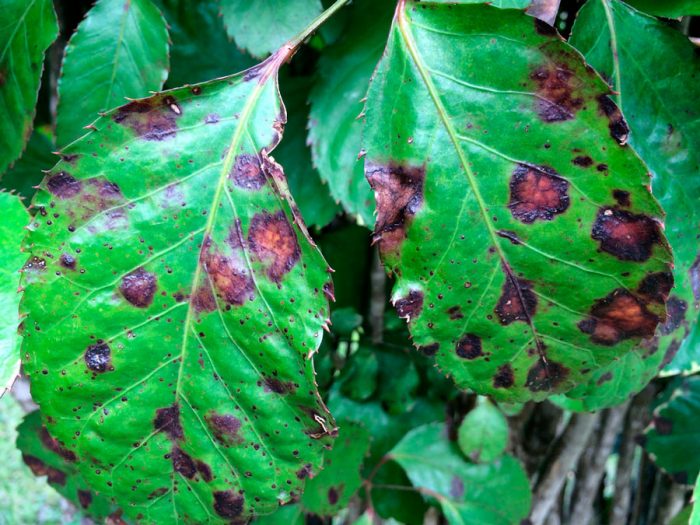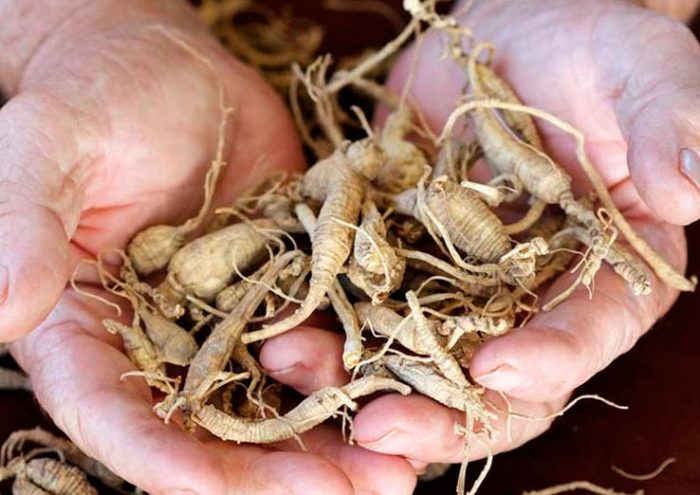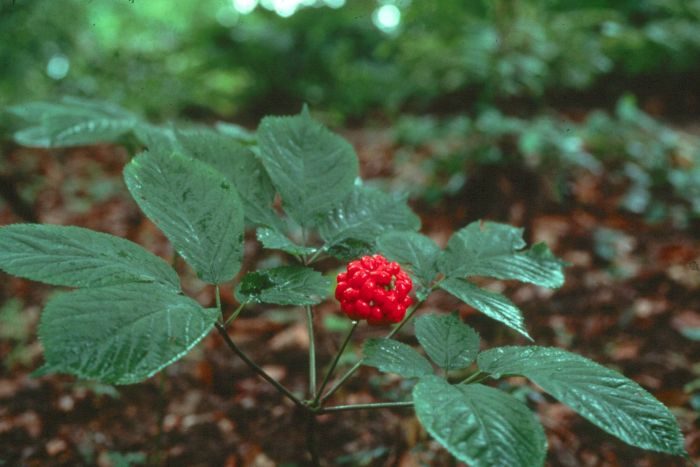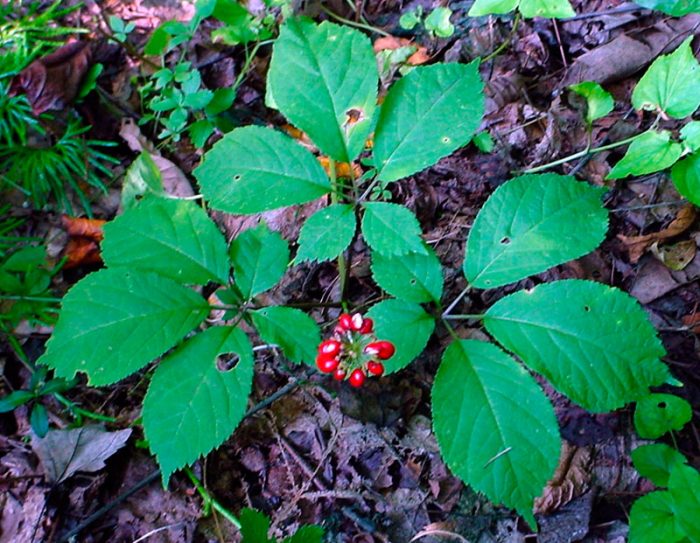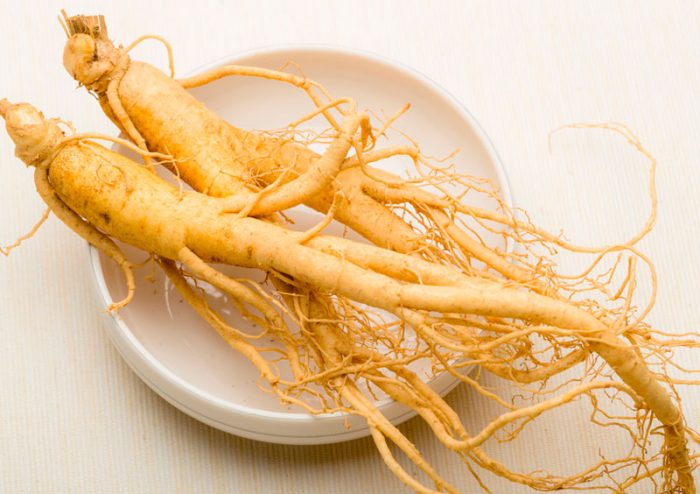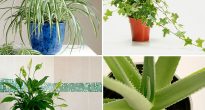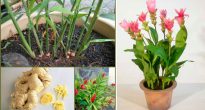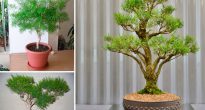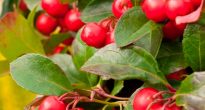The herbaceous perennial plant ginseng (Panax) is a member of the Araliaceae family. This genus unites 12 species. In nature, they can be found in North America and Asia (Tibet, Altai, the Far East and China). Humanity has known for a long time that such a culture has healing properties, it is most often used as a tonic and adaptogen. Ginseng root in Korea and China is used in cooking. Officials in China are confident that this plant can prolong life and give strength.
Content
Features of ginseng
The root of ginseng is a rod-shaped branching spindle-shaped root, it reaches 25 centimeters in length and 0.7–2.5 centimeters wide. One root has 2–5 branches. The neck with traces of annual shoots is placed in the upper part of the root, you can find out the age of the bush by their number. The color of the surface and cut of the root is whitish-yellow or white. Its aroma is specific, and the taste is sweetish. The height of the stem can vary from 0.3 to 0.7 m; at its apex there is a whorl, consisting of 2–5 palmate-complex leaf plates with long petioles. During flowering, umbrellas grow, consisting of greenish star-shaped flowers. A flower arrow grows from the middle of the leaf whorl. The fruit is a red drupe, about 10 mm long, with 2-3 wrinkled yellow-gray seeds inside it.
Growing ginseng in the garden
Landing rules
For planting ginseng, those areas where tomatoes, potatoes and cucumbers grew are not suitable, since there is a high probability that it will be affected by infections preserved in the soil, to which these vegetable crops have no resistance. When choosing a place for planting, you also need to take into account the fact that such a plant reacts extremely negatively even to a short-term stagnation of moisture in the root system, in this regard, in the selected area, the groundwater must lie very deep, the soil must be permeable and well-drained, and itself it should be located on the north-east or north-west slope, which is illuminated by the sun only in the evening or morning.The bush reacts negatively to both direct sunlight and shade, in this regard, it is necessary to figure out how to shade it. Experts advise choosing an area for planting that is under the lacy shade of trees, but it should be borne in mind that they should let in from 20 to 25 percent of the sun's rays. Before planting ginseng, the soil on the site must be prepared, as it must meet the requirements of the given culture. The composition of the soil should be similar to taiga soil, namely: it should be neutral (5.7-7.0 pH), air and moisture permeable, loose, and it should also contain a sufficient amount of organic matter and humus. Experts advise you to prepare a suitable soil mixture yourself. It can include leaf humus, sod land, vermicompost, deciduous forest litter, peat, rotted sawdust, coarse sand, lake silt, ash, soot, rotten wood dust of a fine fraction or crushed eggshells.
Prepare the beds, the height of which should be 0.3–0.4 meters, and the width - up to 1 meter, should be 3-4 months before the day of planting. The length of the bed can be as you need, but you need to remember that it should be placed from west to east. The sowing material needs compulsory pre-sowing preparation, while it includes 2 periods of stratification, and the duration of each is from 4 to 5 months. First, the seed is stratified with heat (from 18 to 20 degrees), and then cold (from 1 to 2 degrees). If the seller from whom you purchase the seeds is responsible, then he himself is engaged in the pre-sowing preparation, such seed material just needs to be sown. The purchased seeds need to be well examined, so if they have gone through all the stages of stratification, there will be cracks on the surface of the seeds, but if they are not there, then this means that the seed was not prepared.
On the prepared bed, grooves with a depth of 50 mm must be made, while the distance between them should be about 100 mm. During sowing, a distance of 20 to 30 mm should be kept between the seeds. When planting ginseng seedlings in the ground, the distance between the bushes should be from 10 to 15 centimeters, and the width between the rows should be 20 centimeters, while the bud should be buried no more than 50 mm in the soil. Each plant must be laid in the ground at an angle of 45 degrees with the head to the east. When the seedlings are planted or the seeds are sown, the garden must be well watered. It is not worth expecting that the seedlings will appear soon, sometimes it happens after a few months.
Ginseng Garden Care
If the seedlings appear in springtime, then return frosts can harm them. To prevent this from happening, the plant should be protected; for this, special metal arcs are installed over the garden bed, onto which the covering material is pulled. This design will also come in handy later, when young bushes need to be protected from direct sunlight. For the first year of growth, only one leaf plate with 3 leaves will form in a bush, a plant that is 4 years old can have 3 or 4 leaf plates with 4 or 5 leaves. But already from the age of five, the number of foliage does not increase.
On average, the garden bed is watered once every 7 days, while for every one square meter of the plot, from 2 to 3 liters of water should go away. Only water heated in the sun and well-settled water should be used for irrigation, while potassium permanganate must be poured into it each time so that the liquid becomes pinkish. During the first year of the life of the bushes, it is necessary to loosen the surface of the soil and remove weeds from the beds manually. During the summer period, you will need to carry out at least 10 loosening. In order to reduce the number of watering, the surface of the garden bed must be covered with a layer of mulch (sawdust, humus or pine needles).
In autumn and spring, the bushes are fertilized; for this, wood ash is added to the soil (150-200 grams per 1 square meter of the plot). The roots begin to gain mass only after the fruits are formed. Therefore, from August, after the fruits ripen, the bushes will need daily sunbathing, but the rays must be oblique. In late autumn, the surface of the site must be covered with a two-centimeter layer of vermicompost, thanks to which the bushes will not only be reliably protected from frost, but also receive nutritious feeding.
Diseases and pests
Ginseng is not highly resistant to harmful insects and diseases. Due to the fact that the garden bed is regularly watered with a weak solution of manganese potassium, this helps to protect the bushes from being affected by fungal diseases. But experts advise, regularly at the beginning of the spring and late autumn to process the site and the aisles with a solution of Bordeaux mixture (1-2%), and throughout the season the plants should be sprayed over the foliage with a solution of pinkish potassium manganese (1 gram of substance per 100 liters of water) , while it must be washed off the sheet plates with clean water.
For this culture, pests such as slugs, mice, bears, aphids, moles, wireworms, and also the larvae of May beetles, are especially dangerous. It is necessary to deal with these pests by manual collection with their subsequent destruction. For a short time, infusions prepared on marigolds, tobacco, needles, garlic, wormwood, dandelions or wood ash will help protect the bushes from insects. It is recommended to pour a small amount of liquid soap into the infusion for stickiness.


Watch this video on YouTube
Collecting and storing ginseng
Ginseng roots will reach commercial quality only by 5-6 years. At this point, their weight may be 20–100 g, and in some cases even more. When half a month is left before digging out the roots, it is necessary to stop watering the plants altogether, thanks to this it will be much easier to pull the bushes out of the soil. The dug roots must be thoroughly rinsed under running water using a brush, while trying to remove the remnants of the earth, then they must be dried. Fresh raw materials can be folded into a plastic bag and placed on a refrigerator shelf, where they can lie for several weeks. However, only dried roots are suitable for long-term storage. If the roots are small, then they can be dried whole, while the large roots should be cut into plates, the thickness of which can vary from 0.5 to 0.7 cm.In room conditions, the roots can be decomposed on central heating radiators or they are put in an electric dryer. where it is dried at a temperature of 50 to 60 degrees. For storage, the finished raw materials are put in glass jars, which are tightly closed and stored in a dry and dark place. It retains its beneficial properties for no longer than 5 years.
The foliage is collected in September. Only bushes over three years old are suitable for this. The raw material should be spread out in a thin layer in a shaded place to dry. Dried foliage is poured into cardboard boxes or paper bags, where they will be stored for no longer than 1 year.
Types and varieties of ginseng with photos and names
Of all the types of ginseng, only two have healing properties, namely:
Common ginseng (Panax ginseng)
A description of this type can be found at the beginning of the article. Every year in natural conditions, it can be found less and less, but in culture it is very widespread.
Five-leaf ginseng (Panax quinquefolium)
Or American ginseng, or pearl ginseng. The homeland of this type is North America and the Himalayas. In natural conditions, it is also not very widespread, but it is grown in France, China and Wisconsin. This type differs from the others in that it has a cooling effect.
Properties of ginseng: harm and benefit
Healing properties of ginseng
There are many legends that ginseng has incredible healing power. They say that it contributes to the return of youth, getting rid of all diseases and can even raise hopeless patients to their feet. In these legends there is some truth, and such a healing power of this plant is explained by its unusual composition. So, the composition of the root includes resins, alkaloids, sulfur, phosphorus, tannins, macro- and microelements and vitamin C. spent bile, lowering blood sugar. It is used as a remedy that relieves physical and mental stress, as well as stress, and it also has a sedative effect in neuroses. Also, this plant helps to improve vision and memory, strengthen the immune system, normalize metabolic processes, and with the help of it, wounds heal much faster.
If a man has problems with potency, then experts recommend him to use the root of this plant for 8 weeks. At the end of this course, sexual function will be fully restored, and sperm motility will also noticeably improve.
This plant is used in the form of tinctures, powders, extracts, ointments and tea. Experts prescribe a ginseng extract if there is a weakening of sexual function or hypotension, and it also helps with fatigue and restores strength after stress or after a serious illness. In alternative medicine, ginseng tincture is widely used, which has metabolic, antiemetic, adaptogenic, biostimulating and tonic effects. The composition of such a product includes peptides, saponin glucosides, minerals, vitamins, essential and fatty oils.


Watch this video on YouTube
Contraindications
Such a plant, as well as the products prepared on its basis, are forbidden to be used by pregnant women, with bleeding, increased nervousness, and also various inflammations. It is considered a powerful stimulant, and therefore in some cases contributes to the development of headaches, nausea, vomiting, and also contributes to the deterioration of well-being in hypertensive patients. Experts do not advise people who are under 45 years old to take it. And even if you do not have a single contraindication, before you start taking ginseng, you should definitely consult with a qualified specialist.

